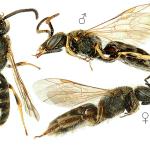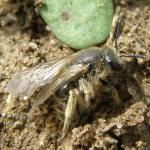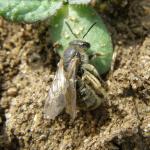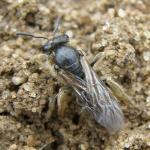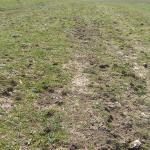Lasioglossum longulum CURTIS, 1833
This is one of the larger Lasioglossum species in Britain, and the distinctive right-angled front corners of the pronotum are easily seen under the microscope.
Southern England and the Channel Islands. Formerly a scarce and very local species but, since about 1990, it has been extending its range in England and is common to locally abundant in many sites in the southern counties. Widely distributed in the western Palaearctic, its range extending from Denmark to the Azores and North Africa (Morocco), eastwards throughout central and southern Europe to Iran.
This species is not regarded as being scarce or threatened.
Coastal cliffs and landslips, abandoned quarries, commons, chalk grassland and private gardens.
Females from early April to October; males from early July to the beginning of October. G M Spooner (pers. comm.) found several active gynes on the Dorset coast in mid-February.
Commonly nests in aggregations, occasionally of considerable extent, especially in exposed soil at the base of coastal cliffs and similar unstable locations where vegetation is sparse. Nest burrows are often observed in the hard trodden soil of footpaths. Sites at the top of beaches are sometimes deluged by sea water during winter storms. A well known eusocial species, its development being one of the most extensively documented of any Palaearctic halictine species. Important references include Stoeckhert (1923), Legewie (1925), Noll (1931), Bonelli (1948), Michener (1974) and Westrich (1989). The worker is smaller than the gyne and was originally described as a distinct species, Halictus longulus Smith, 1848.
Includes cinquefoil (Potentilla spp.), colt's-foot (Tussilago farfara), common fleabane (Pulicaria dysenterica), creeping thistle (Cirsium arvense), dandelion (Taraxacum officinale), fennel (Foeniculum vulgare), field bindweed (Convolvulus arvensis), hawkweed (Hieraceum spp.), mayweed (Tripleurospermum spp.), oxtongue (Picris echioides), stonecrop (Sedum spp.) and wild parsnip (Pastinacea sativa).
L Packer (pers. comm.) has excavated the cleptoparasite, Sphecodes monilicornis (Kirby) and larvae of the oil beetle Meloe proscarabaeus Linnaeus from nest burrows of this bee on the Isle of Wight.
2005


